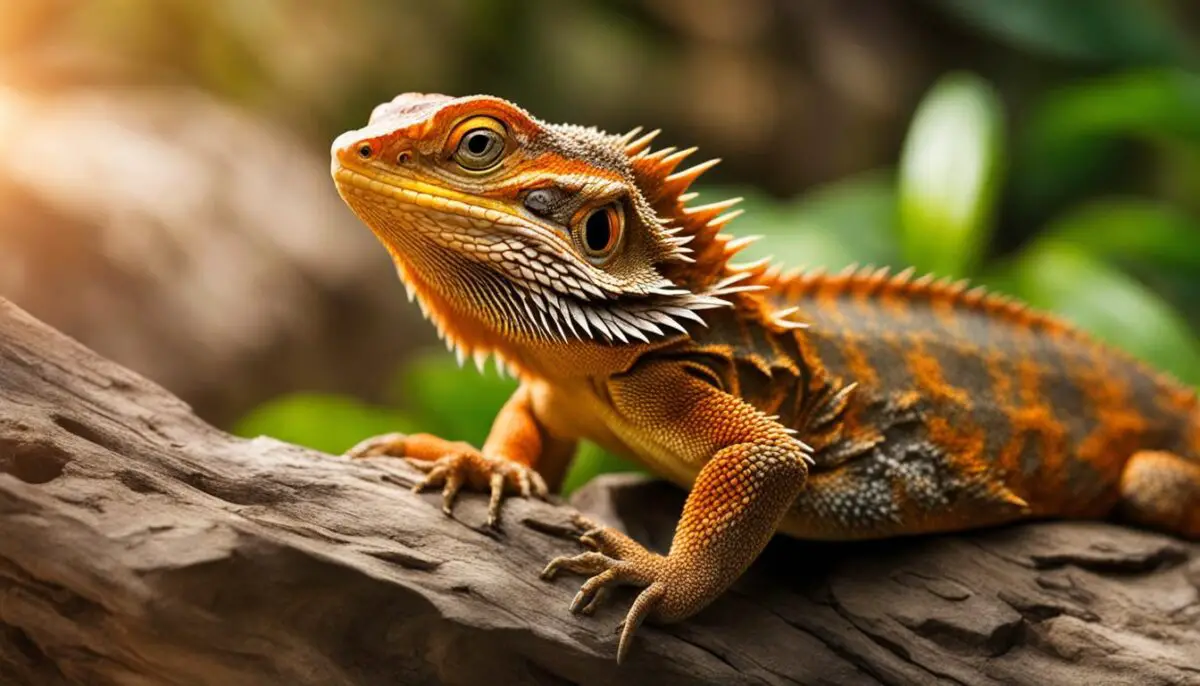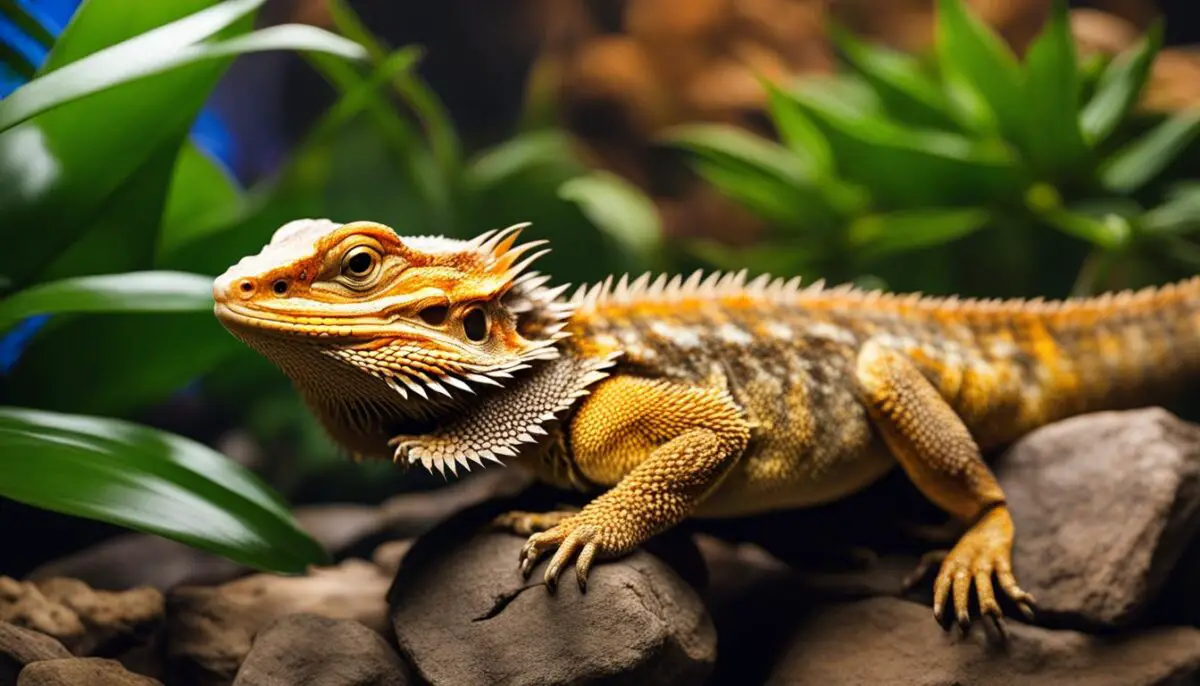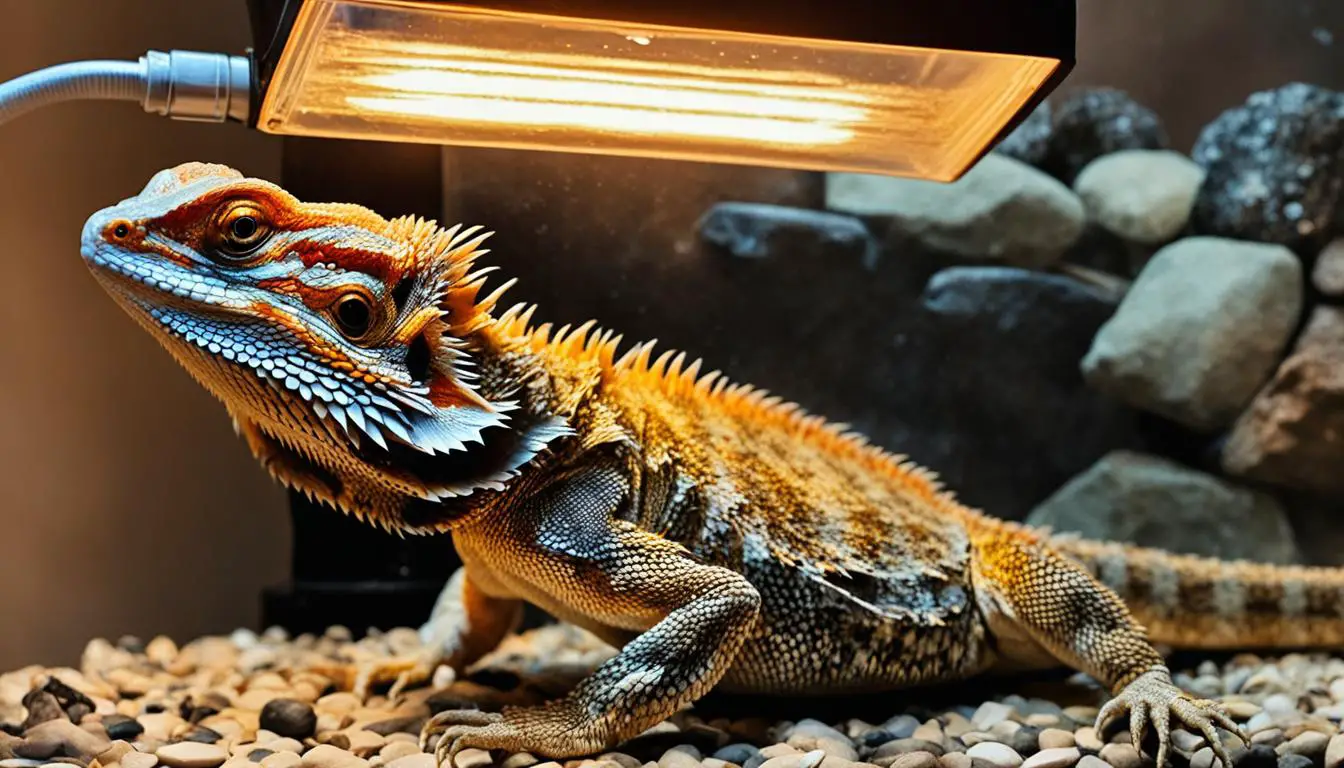Welcome to the ultimate guide to owning a bearded dragon! If you’re considering getting a bearded dragon as a pet or already have one, this comprehensive guide will provide you with all the information you need to ensure the health and happiness of your scaly friend.
Bearded dragons, scientifically known as Pogona vitticeps, are native to Australia and have become increasingly popular as pets due to their cute appearance, docile nature, and ease of care. These dinosaur-looking reptiles have unique skin colors and patterns, with spiny scales and beard-like collars around their throats, which gives them their name.
In this guide, we’ll delve into various aspects of owning a bearded dragon, including their appearance and origin, why they make good pets, their care and setup, diet and feeding requirements, health and handling tips, as well as information on where to find supplies and reliable breeders.
Key Takeaways:
- Owning a bearded dragon can be a rewarding experience for reptile enthusiasts.
- Bearded dragons are native to Australia and belong to the Pogona genus.
- They are diurnal reptiles and thrive in extreme heat and light.
- Bearded dragons are omnivorous and require a balanced diet.
- Proper care and setup, including heating, lighting, and habitat, are crucial for their well-being.
Appearance and Origin of Bearded Dragons
Bearded Dragons are fascinating reptiles with unique appearances. They have spiny scales, and the most distinctive feature is the beard-like, spiky collars around their throats. When threatened or displaying dominance, they inflate their collars to intimidate others.
These intriguing creatures originate from Australia, where they can be found in the arid desert regions of the continent. There are eight different species of bearded dragons, with the Central or Inland Bearded Dragon (Pogona Vitticeps) being the most recognized and commonly kept as a pet.
Due to the export restrictions imposed by Australia, bearded dragons are now bred in captivity and have become popular pets worldwide. Breeders have successfully created hybrids with various colors, patterns, skin transparencies, and sizes, offering a wide range of options to potential pet owners who are looking for a visually stunning companion.
Types of Bearded Dragons
Here’s an overview of the different types of bearded dragons:
| Species | Scientific Name | Appearance |
|---|---|---|
| Inland Bearded Dragon | Pogona vitticeps |  |
| Western Bearded Dragon | Pogona minor | Distinctive dark-bearded appearance |
| Eastern Bearded Dragon | Pogona barbata | Sandy to light brown coloration with a yellow beard |
| Rankin’s Dragon | Pogona henrylawsoni | Smaller size, shades of brown with white and yellow markings |
| Black Soil Bearded Dragon | Pogona henrylawsoni | Darker coloration with dark beard |
| Kimberley Bearded Dragon | Pogona microlepidota | Mottled gray-brown with dark bands and a yellow or white throat |
| Nullarbor Bearded Dragon | Pogona nullarbor | Light gray-brown with pale markings |
| Mitchell’s Bearded Dragon | Pogona mitchelli | Bright colors and striking patterns |
Each species has its own unique characteristics and color variations, making them a captivating choice for reptile enthusiasts.
Why Bearded Dragons Make Good Pets
Bearded Dragons are not only fascinating creatures but also make excellent pets. Their adorable appearance and gentle temperament make them an ideal choice for reptile enthusiasts. Let’s explore why these scaly companions are loved by pet owners:
1. Cute Appearance and Docile Nature
Bearded Dragons have a unique charm with their spiny scales and beard-like collars. Their friendly and docile nature makes them easy to handle and interact with. Whether you’re a beginner or an experienced reptile owner, bearded dragons make delightful companions.
2. Easy to Interact With
Unlike some nocturnal species, bearded dragons are diurnal creatures, meaning they are active during the same times as humans. This synchronization makes it easier to spend quality time with them, observe their behavior, and build a bond.
3. Versatile Diet
Beardies are not picky eaters and have a versatile diet. They enjoy a combination of insects, fruits, vegetables, and greens. This variety in their diet allows you to provide them with a well-rounded and nutritious meal plan.
4. Ideal Size for Homes and Handling
Bearded Dragons are the perfect size for most homes. They are small enough to accommodate in a dedicated enclosure but large enough to be handled by children. This size makes them a great choice for families looking for a reptile pet that can be easily cared for and enjoyed by everyone.
5. Long Lifespan
When well-cared for, bearded dragons can live for 4-12 years. This extended lifespan gives owners ample time to form a strong bond and create lasting memories with their scaly friend.
6. Affordable Care Costs
Compared to some other pets, bearded dragons have relatively low care costs. While there are initial setup expenses for their enclosure, heating, lighting, and feeding, the recurring maintenance costs are affordable. The initial setup costs for a bearded dragon enclosure can range from $150 to $500, depending on the choice of habitat and accessories.
Overall, bearded dragons are wonderful pets that provide companionship and joy to their owners. Their cute demeanor, ease of care, and longevity make them a great addition to any reptile-loving household.

By providing a well-designed habitat setup with proper temperature, lighting, substrate, and decorations, you can ensure the optimal care and well-being of your bearded dragon.
Bearded Dragon Diet and Feeding
Providing a proper diet is essential for the health and well-being of your bearded dragon. These omnivorous reptiles have specific nutritional requirements that should be met to ensure their optimal growth and development. By following a balanced feeding regimen, you can help your bearded dragon thrive.
What to Feed Your Bearded Dragon
A varied diet is crucial for bearded dragons to obtain the necessary nutrients. Their diet should consist of approximately:
- 70% Vegetables and Greens: Offer a wide variety of leafy greens and colorful vegetables to provide essential vitamins and minerals. Good options include kale, collard greens, squash, and bell peppers.
- 20% Insects: Bearded dragons require protein, which can be obtained from feeding them insects such as crickets, mealworms, and dubia roaches. These insects should be gut-loaded or fed nutritious food to provide maximum nutritional value.
- 10% Fruits: While fruits should be given in moderation, they can be offered as occasional treats. Berries, melons, and papayas are some suitable options.
It’s essential to maintain the proper balance of these food groups to ensure your bearded dragon receives all the necessary nutrients.
Supplements for Optimal Nutrition
In addition to a varied diet, bearded dragons require calcium and vitamin supplements to meet their nutritional needs. Calcium is crucial for bone health and muscle function, while vitamins help support their overall well-being. Dusting insects with a calcium supplement before feeding them to your bearded dragon can ensure they receive adequate calcium intake. Vitamin supplements can be added to their food a few times a week to supplement their diet.
Water Intake
Bearded dragons obtain most of their hydration from their food. However, it’s still important to provide a shallow dish of fresh water in their enclosure. This allows them to drink if they feel the need for additional hydration.

Remember to observe your bearded dragon’s feeding habits and adjust their diet accordingly. Offer a variety of foods and monitor their health and weight to ensure they are thriving. By providing a well-balanced diet and proper nutrition, you can contribute to the long-term health and vitality of your bearded dragon companion.
Bearded Dragon Health and Handling
While bearded dragons are generally hardy reptiles, they can still experience health issues. It’s important for owners to be aware of common diseases and health concerns that can affect their bearded dragons. Some of these include:
Metabolic Bone Disease (MBD): This condition occurs when a dragon’s body is unable to metabolize calcium properly, leading to weak bones and skeletal deformities. It can be caused by a lack of UVB lighting or an improper diet.
Respiratory Infections: Bearded dragons can develop respiratory infections if they are kept in conditions with poor ventilation or if their habitat is too damp or cold.
Parasites: External and internal parasites, such as mites, ticks, and worms, can infect bearded dragons. Regular veterinary check-ups and proper hygiene can help prevent parasite infestations.
Shedding Problems: Like other reptiles, bearded dragons shed their skin periodically. Occasionally, they may have difficulty shedding, leading to retained shed or issues with their eyes. Proper humidity and regular baths can help with the shedding process.
Prevention and proper care are key to maintaining the health of your bearded dragon. Regular veterinary check-ups are essential for early detection and treatment of any health issues. Providing a balanced diet, suitable habitat, and appropriate heating and lighting conditions are essential for their overall well-being.
Handling a bearded dragon requires gentle and confident techniques. Here are some tips for handling:
- Approach your dragon calmly and confidently to avoid causing stress.
- Support their body with both hands to ensure they feel secure.
- Respect their personal space and avoid sudden movements.
- Start with short handling sessions and gradually increase the duration to allow your dragon to acclimate.
Regular handling not only helps to build a bond between you and your dragon but also helps to socialize them. Through handling, you can observe any changes in their behavior or health and address them promptly.
| Common Diseases | Symptoms | Treatment |
|---|---|---|
| Metabolic Bone Disease (MBD) | Weakness, deformities, loss of appetite | Increased calcium supplementation, UVB lighting, proper diet |
| Respiratory Infections | Coughing, wheezing, mucus discharge | Antibiotics, appropriate habitat conditions |
| Parasites | Weight loss, lethargy, poor appetite | Parasite treatment prescribed by a veterinarian |
| Shedding Problems | Retained shed, difficulty shedding | Increased humidity, warm baths, gentle assistance with shedding |
Conclusion
Owning a bearded dragon can be a fulfilling experience for reptile enthusiasts. With proper care and setup, these unique creatures can thrive as pets, bringing joy and companionship to their owners.
To ensure the well-being of your bearded dragon, it is crucial to provide them with a suitable habitat. This includes maintaining the right temperature and lighting conditions, as well as creating a spacious enclosure with appropriate decorations and hiding spots.
Regular veterinary check-ups and attention to their dietary and environmental needs are vital for their overall health. Bearded dragons require a balanced diet consisting of a variety of insects, vegetables, fruits, and greens. Additionally, providing calcium and vitamin supplements is necessary to meet their nutritional requirements.
When handling a bearded dragon, remember to be gentle and respectful. Supporting their body and giving them space will help build trust and create a positive bond. By following these tips and guidelines, you can ensure a happy and healthy life for your scaly friend.
FAQ
What is the appearance of a bearded dragon?
Bearded dragons are spiny reptiles with unique skin colors and patterns. They have spiky collars around their throats, which they can inflate to intimidate others.
Where do bearded dragons come from?
Bearded dragons are native to Australia, specifically the arid desert center of the continent. There are eight different species of bearded dragons, with the Central or Inland Bearded Dragon being the most recognized.
Why do bearded dragons make good pets?
Bearded dragons make good pets because of their cute appearance and docile nature. They are awake during the same times as their human caretakers, making interaction easier. They are small enough for most homes but large enough to be handled by children. Additionally, they are relatively inexpensive to set up and maintain.
How should I set up an enclosure for a bearded dragon?
To set up an enclosure for a bearded dragon, you will need a suitable habitat with proper heating and lighting. The enclosure should be spacious enough for the dragon to move around comfortably. The temperature should be maintained between 95-110°F on the basking spot and 75-85°F on the cool side. UVB lighting should be provided for at least 10-12 hours a day. The substrate used in the enclosure should be safe and easy to clean, such as reptile carpet or newspaper. Decorations like basking branches, rocks, and hiding spots provide enrichment for the dragon.
What should I feed my bearded dragon?
Bearded dragons are omnivorous and require a balanced diet. Their diet should consist of approximately 70% vegetables and greens, 20% insects, and 10% fruits. Insects like crickets, mealworms, and dubia roaches can be fed to provide protein. Vegetables and greens like kale, collard greens, and squash should be offered daily. Fruits like berries and melons can be given as treats. It is important to provide calcium and vitamin supplements to ensure proper nutrition.
What are common health concerns for bearded dragons?
Common health concerns for bearded dragons include metabolic bone disease, respiratory infections, parasites, and shedding problems. Regular veterinary check-ups and proper care can help prevent and address these issues. Handling a bearded dragon requires gentle and confident handling techniques. Regular handling can help socialize the dragon and build a bond with their caregiver.


